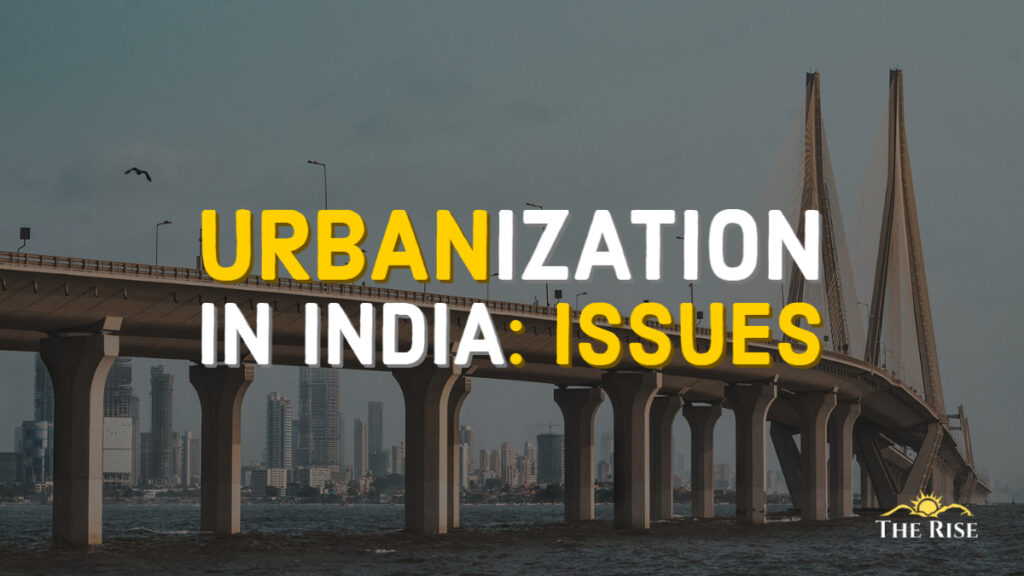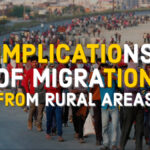Our TRIP intern Abhishek analysed how sustainable is the ongoing prevalent phenomenon of urbanization in India. This article is an outcome of the internship.
Urbanization is an indicator of evolution from conventional rural economies to modern industrial economies. It represents the progressive concentration on the population in an urban area. India shares a large proportion of urbanization in developing countries. In the 20th century, it has significantly affected national life in all aspects. According to the 2011 Census, the urban population of the country has increased from 25.85 million (in 1901) to 377.11 million (in 2011). Out of 7935 towns in the country, almost 468 cities in India have recorded more than one lakh population and 53 cities with more than one million populations. Two of the world’s most populous cities belong to India including the capital Delhi (2nd position) and Mumbai (5th position) (Urban Ecology, 2014).
Also Read: Implications of Migration from Rural Areas
Historically, the war with Pakistan and China in 1962 and 1965 resulted in a recession, which was further hit by drought in 1967. This hindered the process of industrialization which had begun in the sixties. Therefore, a shift in population from rural to urban areas didn’t make a large difference before 1960. The highest growth rate in urban areas was recorded during the 1970s, which got relatively reduced in 1980s and 1990s (Jaysawal & Saha, 2014).
The urbanization pattern in India is marked by the continuous aggregation of people and activities in big cities.
The urbanization pattern in India is marked by certain unique characteristics: showing growth in class-I cities, occurrences of urbanization without a strong economic base, rural push factor, and the rapid urbanization leading to poverty, unemployment, inequalities, and decay in the quality of urban life.
Also Read: Resuscitating Migrant Workers to Economy
Most of the class-I cities such as Delhi, Calcutta, Bombay, Chennai face some basic issues of housing, transport, sanitation, water supply, slums, pollution, etc. These cities use capital intensive technologies, which act as an obstacle in generating employment for these rural migrants. Hence, these megacities are subject to slums, electricity, water problems, and rural migrants.
The housing facility expansion has failed to catch the rapid demand for urbanization and poor migrants were compelled to live in slums.
Growth in these cities is expanding both horizontally and vertically. The mushrooming growth of busy centres and apartments is a common sight in Indian cities (Jayaswal & Saha, 2014). However, housing facilities in urban areas is a serious issue hampering the urban cities. The housing facility expansion has failed to catch the rapid demand for urbanization and poor migrants were compelled to live in slums. Living in slum degrades the health and education facilities of these migrants (Kundu, 1994).
These slums are in extremely unhygienic conditions without proper sanitation facilities open to diseases like malaria, diarrhoea, jaundice typhoid, etc. (Wankhade, 2015). Excessive construction in cities to accommodate more people is leading Government authorities to exploit more resources.
Also Read: Villages: The New Wheels of Economy in Post-Pandemic World
The unplanned transport system continues to plague these megacities with heavy traffic jams, rise in fuel prices and pollution. Increase in road accidents and parking of vehicles has become a major problem. Public transport systems in cities have evolved with time but the cities failed to fully solve the transport system.
Unauthorized construction in these cities is also a big reason for inefficient civic amenities
Urban waste of building materials, hospital wastes, industrial waste are dumped onto the public spaces. The sewage system is also not properly installed in the old part of many urban cities where garbage waste can not be handled due to its enormous volume. Unauthorized construction in these cities is also a big reason for inefficient civic amenities (Kundu, 1994). This affects the water supply system and many of the sewage lines are draining into the nearest water bodies. The Yamuna flowing via Delhi has turned into a sewer from the urban waste which is directly flowing in. Drainage systems in megacities like Delhi, Mumbai, Gurgaon, and Chennai have failed badly and floods have become a regular phenomenon. In the areas of Indo-Gangetic plains, the situation is worse and water remains logged throughout the monsoon period (Kumar & Joseph 2012).
A large number of migration occurring in urban cities constantly challenges the education facilities.
Large amount of migration towards urban cities continues to challenge the education facilities. The inequalities in economic activities is still prevalent. Low skilled or unskilled migrants coming from rural areas are working in the low-grade informal sector at very low wage-rate. The crime rate is another concerning factor in urban cities as it creates a fearful environment.
Water supply in the cities has been a big issue all around. Various small towns depend on individual water sources. In this case, substantial migration in these areas has resulted in water scarcity. Pollution in these cities is causing human health issues. According to World Bank report, over forty thousand Indians are dying due to air pollution and a large number of people are suffering from respiratory diseases. Most of these cases are in urban centres of the country.
Most of the megacities are working rapidly to change the dietary habits in urban areas. People are shifting to pre-prepared foods for long working hours. The role of supermarkets has expanded favouring the larger agricultural producers. A change in the food chain can be seen where fewer people are working in agriculture and more are working in wholesaling, transport, retailing, and vending (Satterthwaite et. al, 2010).
Improvement in policy planning & urban infrastructure and land use planning is essential to regain the lost momentum of the urban environment in the country.
To tackle all these troubles of urbanization, the government has come up with the “Smart Cities” project. The government aims to refine the transport, planning, water supply, waste management, education, healthcare facilities in twenty smart cities. Since some of the megacities have reached a level where employment generation and over-crowding are a general phenomenon, the role of these smart cities will be very significant in reducing the pressure on megacities and helping to maintain their economy.
The overall economic structure of urban areas in countries is severely affected due to the rapid urbanization in recent times. Operational planning is required in most of the urban areas to restore a strong economic base. Improvement in policy planning & urban infrastructure and land use planning is essential to regain the lost momentum of the urban environment in the country.
References:
- Satterthwaite, David, et.al. Urbanization and its implications for food and farming. The Royal Society, 2010, pp 2809-20.
- Jayasawal, Neelmani, and Sudeshna Saha. Urbanization in India: An Impact Assessment. Scientific & Academic Publishing, 2014, pp 60-65.
- Singh, Govind. Urbanisation Trend and Pattern in India: Census 2011 and Beyond. Urban Ecology, 2014. Viewed on 15th October 2020. Available at http://urbanecology.in/2014/10/10/urbanisation-trend-and-pattern-in-india-census-2011-and-beyond/
- Shukla, Kamlesh Kumar, et.al. Urbanisation and Migration Trends in India. Demography India, Vol. 39, No. 1, 2010, pp. 43-54.
- Tripathi, Sabyasachi. An Overview of India’s Urbanization, Urban Economic Growth and Urban Equity. International Journal of Economics and Empirical Research. Vol. 3(3), 2015 pp 115-127.
- Kundu, Amitabh. Pattern of Urbanisation with Special Reference to Small and Medium Towns in India. Har-Anand Publications, 1994.
- Kumar, S. Ganesh and Nitin Joseph. Drainage and sewerage system in urban India: Need for action. Indian Journal of Occupational and Environmental Medicine, Vol. 16(3), pp. 150-151.
- Wankhade, Kavita. Urban sanitation in India: key shifts in the national policy frame. Sage Publication, Vol 27(2), 2015, pp 555–572.













Pingback: The Song of Urban Forest - TheRise.co.in